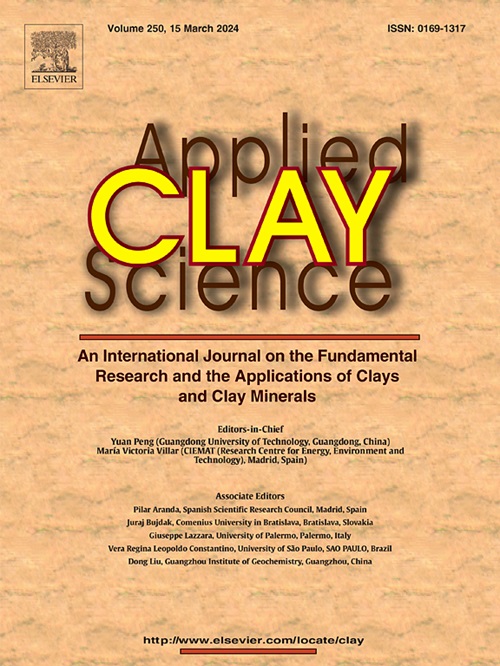元粘土傅立叶变换红外光谱的化学计量学:从加热温度估算到元粘土鉴定
IF 5.8
2区 地球科学
Q2 CHEMISTRY, PHYSICAL
引用次数: 0
摘要
在这项研究中,利用化学计量学工具(例如部分最小二乘回归、主成分回归、线性判别分析)可以估计烧成温度,并根据红外光谱确定元粘土的类型:在粘土热降解过程中观察到的 3 个分阶段是:(i) 400 至 500-600 °C 之间的脱羟基反应,导致形成非结晶的元粘土;(ii) 500 至 850 °C 之间元粘土涉及 SiO 键的连续热降解反应;(iii) 850 °C 以上形成次生硅酸盐。部分最小二乘法回归模型的 10 个潜在变量得出了准确的预测结果(预测的均方根误差 = 66.6),并在预测温度和实际温度之间提供了良好的相关性,没有任何与粘土类型、其他矿物的存在或铁浓度有关的估计偏差。这些模型更重视参与热降解的键的红外吸收带:最后,提出了线性判别分析模型,以便在 96% 的情况下识别不同类型的元高岭土、元黑云母和元闪长岩之间的元粘土类型。从红外光谱上看,焙烧埃洛石、屌石和高岭石产生的元粘土过于接近,无法区分。本文章由计算机程序翻译,如有差异,请以英文原文为准。
Chemometrics of meta-clay FT-IR spectra: From heating temperature estimation to meta-clay identification
In this research, chemometric tools (Partial Least-Squares Regression, Principal Component Regression, Linear Discriminant Analysis for example) allowed estimating firing temperatures and to identify the type of meta-clay based on their infrared spectra.
The 3 min phases observed in clay thermal degradation were: (i) a dehydroxylation reaction between 400 and 500–600 °C leading to the formation of a non-crystalline meta-clay, (ii) a continuous thermal degradation reaction of the meta-clay involving the Si![]() O bonds between 500 and 850 °C, (iii) the formation of secondary silicates above 850 °C.
O bonds between 500 and 850 °C, (iii) the formation of secondary silicates above 850 °C.
The 10 Latent Variables of the Partial Least-Squares Regression model led to accurate predictions (Root Mean Squared Error of Prediction = 66.6) and provided a good correlation between predicted and actual temperatures, without any estimation bias related to the type of clay, the presence of other minerals or iron concentration. These models give greater importance to the infrared absorption bands of the bonds involved in thermal degradation: Si-O-Si (1026 and 461 ), Si-O-Al (526 ), Si![]() O or Al
O or Al![]() O (1095 ), and infrared bands resulting from the formation of meta-clays (486 et 562 ).
O (1095 ), and infrared bands resulting from the formation of meta-clays (486 et 562 ).
Finally, a Linear Discriminant Analysis model is proposed in order to identify the type of meta-clay between different types of meta-kaolinites, meta-nacrite and meta-smectite in 96 % of cases. The meta-clays produced by the firing of halloysite, dickite and kaolinite were too close in terms of infrared spectra to be distinguished.
求助全文
通过发布文献求助,成功后即可免费获取论文全文。
去求助
来源期刊

Applied Clay Science
地学-矿物学
CiteScore
10.30
自引率
10.70%
发文量
289
审稿时长
39 days
期刊介绍:
Applied Clay Science aims to be an international journal attracting high quality scientific papers on clays and clay minerals, including research papers, reviews, and technical notes. The journal covers typical subjects of Fundamental and Applied Clay Science such as:
• Synthesis and purification
• Structural, crystallographic and mineralogical properties of clays and clay minerals
• Thermal properties of clays and clay minerals
• Physico-chemical properties including i) surface and interface properties; ii) thermodynamic properties; iii) mechanical properties
• Interaction with water, with polar and apolar molecules
• Colloidal properties and rheology
• Adsorption, Intercalation, Ionic exchange
• Genesis and deposits of clay minerals
• Geology and geochemistry of clays
• Modification of clays and clay minerals properties by thermal and physical treatments
• Modification by chemical treatments with organic and inorganic molecules(organoclays, pillared clays)
• Modification by biological microorganisms. etc...
 求助内容:
求助内容: 应助结果提醒方式:
应助结果提醒方式:


